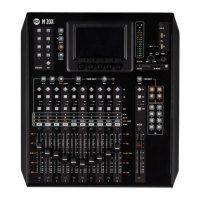
Do you have a question about the RCF M 20 Series and is the answer not in the manual?
| Channels | 20 |
|---|---|
| USB Playback | Yes |
| Mic Inputs | 8 |
| Phantom Power | Yes |
| Line Inputs | 12 |
| Aux Sends | 4 |
| Main Outputs | 2 |
| A/D Resolution | 24-bit |
Details the physical components and layout of the front panel's upper section of the M 20X mixer.
Provides a general overview of the M 20X Digital Mixer's capabilities and signal flow.
Step-by-step guide on how to download, prepare, and install firmware updates onto the M 20X mixer.
Instructions for creating a backup of the mixer's configuration, presets, and settings onto a USB drive.
Steps to load a previously saved backup package onto the M 20X mixer, restoring settings and presets.
Details the processing stages available for input channels, including Channel, Gate, PEQ, Dynamics, and Sends.
Details the processing sections for all outputs, including EQ, Delay, and Compressor/Limiter.
Explains the 4 stereo FX engines, including Reverb, Delay, and Modulation effects with their parameters.
Monitoring input, output, and FX signal levels, including mute status and gain reduction indicators.
Using the Real-Time Analyzer on the CUE bus to analyze frequency content of audio signals.
Configuration and monitoring of the headphone output, controlled by CUE activation or main mix signal.
Configuring Player and Recorder modes for different external storage devices like USB and SD Card.
Operating the internal player in Stereo or Multitrack mode, including browsing songs and playback controls.
Performing stereo or multitrack recordings, managing filenames, and understanding storage formats.
Saving and recalling mixer settings, presets, and global configurations using SHOW memories.
Configuring LAN settings and the local WiFi Access Point, including driver selection and security.
Programming and assigning functions to the 8 User Keys for quick access to scenes, transport, and shortcuts.
Selecting the source for each input channel and FX return channel from available analog, USB, or SD card sources.
Configuring sources for output channels like MIX OUT, AES OUT, and PHONES LR.
Configuring DCA and MUTE groups for simultaneous control of multiple channels and their mute status.
Adjusting routing settings and level/delay values for AES OUT and PHONES outputs.
Performing fader calibration and adjusting LCD/LED brightness for the mixer's surface controls.
Configuring the six custom faders to control various parameters like DCA Groups or FX Sends.
Setting the mixer's boot mode and performing factory resets, with warnings about data loss.
Managing data transfers using external USB drives for importing and exporting user presets and configurations.
Step-by-step process to import various item types (Show, Gate, PEQ, etc.) from a USB drive into the mixer.
Exporting saved shows, presets, and configurations to a USB drive, selecting item types and package names.
Overview of MIDI control change and program change mappings for controlling the mixer with external MIDI controllers.
Provides a summary of channel information, routing, and fader levels for quick access to processing pages.
Displays a summary page of User Key configurations, showing assigned functions for each key.
